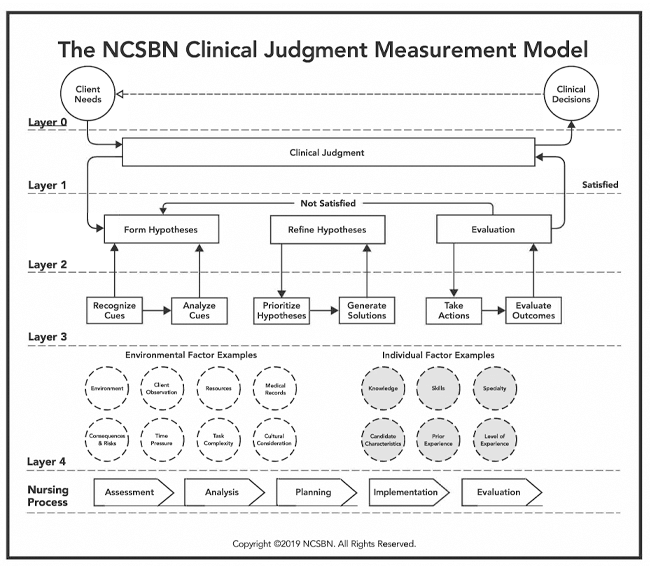When the NCLEX-Next Generation (NCLEX-NGN) launches in April 2023, each examination will include three case studies with six test items. The test items will follow—in order—the six components of Layer 3 of the NCSBN Clinical Judgment Measurement Model (NCJMM).

What is the NCJMM?
The National Council of State Boards of Nursing (NCSBN) is the organization that designs and oversees NCLEX, the licensure exam for nursing candidates. While RN and LPN/LVN candidates do well on NCLEX—over 80% pass the exam on their first try—there is a gap between what they learn in school and how they practice in their job settings as new nurses.
After extensive research, NCSBN developed a new component to NCLEX that can evaluate how well entry-level nurses use clinical judgment and sound decision-making when planning and providing safe client care. Based on professional standards and best practices, the new format adds a multifaceted way to determine if a new nurse can sort through data and create a good outcome.
NCLEX has always had test items that address clinical judgment. Questions that include “BEST,” “PRIORITY,” “FIRST,” or “MOST” guide candidates to select the answer (key) that demonstrates their ability to take the provided data and make the decision that keeps the client safe. These test items will continue to make up most of the NCLEX.
Now there will be evolving case studies that progress through the nursing process by using Clinical Judgment skills. The case studies are called “evolving,” because they mimic what happens during an actual client’s treatment or situation. Each case study has six parts, starting with a “Recognize Cues” test item and finishing with “Evaluate Outcomes.” At each step of the case study, more or different information is given for the candidate to consider. Just as in actual nursing practice, decisions are made with available data.
Layers 3 and 4 represent a process for a nurse’s entire career
NCSBN states, “Layer 3 of the CJMM is essential when considering testing and education of how entry-level nurses develop clinical judgment over time. The six steps comprise a repetitious process that improves over time…in the beginning of a nurse’s career, this [process] is more systematic and deliberate…as a nurse gains clinical experience, the steps…become second nature.”
By adding evolving case studies that follow the process of Layer 3, NCLEX is able to evaluate how well a new nurse is able to apply knowledge from nursing school to real-life situations.
While Layer 3 parallels the pure Nursing Process, Layer 4 adds a dimension that requires more complex clinical judgment. Level 4 provides items that the nurse must include when assessing the client and deciding on actions. These are factors that involve both the environment and the individual nurse.
Level 4 mimics the elements a nurse faces every day: What do I know about this client? Do I understand their medical condition? What do they need to improve? Am I able to provide appropriate care? Do I need to learn more or seek help in this situation?
Environmental factors that the nurse must consider in each client encounter include:
- Environment: Where is the setting? Who is present?
- Client observation: Client demographic, signs/symptoms
- Resources: What is available to provide care for the client?
- Medical records: What is known? What is implied?
- Consequences and risks: Results of treatment, as well as risks
- Time pressure: Acuity of client’s situation, what must be done
- Task complexity: Is the task simple or does it require training?
- Cultural considerations: Sensitivity to client’s cultural needs
Individual factors for each nurse include:
- Knowledge: How much does the nurse know about this diagnosis?
- Skills: Ability of the nurse to provide appropriate assessment and care
- Specialty: Experience and work in specific care settings.
- Candidate characteristics: Does the nurse have any unique attributes?
- Prior experience: Is the nurse familiar with actions required?
- Level of experience: Where the nurse is on the experience spectrum
The new NCLEX-NGN combines Layers 3 and 4 to create unique and realistic client scenarios. Now candidates can be evaluated on expected actions when providing client care. The case studies determine if a nurse can make an appropriate clinical decision.
NCSBN states, “The candidate’s knowledge is utilized throughout each step of the NCSBN Clinical Judgment Measurement Model.”
What are the six Clinical Judgment skills?
- 1
Recognize cues
Cues are pieces of assessment data that the nurse uses to make clinical decisions. The cues indicate what is relevant, essential, or a priority for the nurse to act on. The nurse uses different sources, such as the client’s medical record, vital signs, or laboratory values. Based on available data, the nurse can gather and recognize cues. No hypotheses are formed yet.
- What information is relevant and what is not?
- Of available information, what is most important?
- Is anything of immediate concern?
- 2
Analyze cues
The nurse organized the cues and considers how they relate to the client’s history and current situation. Some cues may be concerning and require immediate intervention. Many clients will have multiple conditions or co-morbidities occurring at the same time, so the nurse may have to narrow down the cues.
- Is the client’s condition consistent with the cues?
- Do the cues support or contradict a particular condition?
- Why is a cue, or set of cues, reason for concern?
- What other information would be helpful or significant?
- 3
Prioritize hypotheses
Now the nurse examines all possibilities for the patient’s situation, including risks and priorities. The nurse determines which possibilities are most likely and/or most serious and ranks them according to urgency, likelihood, risk, complexity, time required, etc.
- Which explanation of the cues is most likely?
- Which explanation of the cues is least likely?
- Is any explanation very serious?
- 4
Generate solutions
Using the hypotheses, the nurse can identify likely conditions and identify expected outcomes. Then the nurse can plan specific actions to reach desirable outcomes. Each action can be evaluated as indicated, contraindicated, or not essential/necessary. The nurse should create multiple possible interventions, not just the best one.
- What are the desirable outcomes?
- What interventions can achieve the outcomes?
- What actions should be avoided?
- Is more information needed?
- 5
Take action
Now the nurse can prioritize care for the client. Actions may include further assessment, monitoring, teaching, documentation, or including other members of the healthcare team. The nurse should avoid “textbook” procedures and consider the factors from Level 4.
- What intervention, or set of interventions, is most appropriate for this client?
- How will the interventions be provided: performed, administered, taught, documented, requested, referred?
- 6
Evaluate outcomes
At this point, the nurse reviews the actions and the trends of the patient’s response to care. Comparing observed outcomes with expected outcomes, the nurse can determine if solutions were effective, ineffective, or made no difference.
- What evidence shows improving, declining, or unchanged status?
- Were the actions or interventions appropriate and effective?
- Are there any actions or interventions that would have been better?
Using the NCJMM in evolving case studies
Every NCLEX-RN ad NCLEX-PN will include evolving case studies. Each case study will go through the steps in Level 3, in proper sequence, starting with Recognize Cues. The case study will cover one scenario or client situation.
As the case study moves to the final step, Evaluate Outcomes, additional data will be provided as in an actual scenario. The client’s condition may change, external factors may be introduced, or the new nurse may encounter an unfamiliar diagnosis. Test items will be structured to mimic a nurse-client interaction.
Nursing schools are already including the new format as part of the curriculum, so NCLEX-NGN should not be a completely new experience. However, preparing for the examination will require practicing the new format, so candidates will feel confident when they sit for the exam. The evolving case studies may seem intimidating, but once the nursing candidate becomes familiar with the format, they will become a logical and natural way to answer test items.
 By
By 



